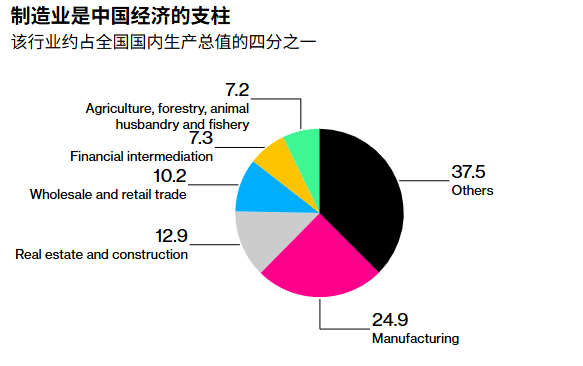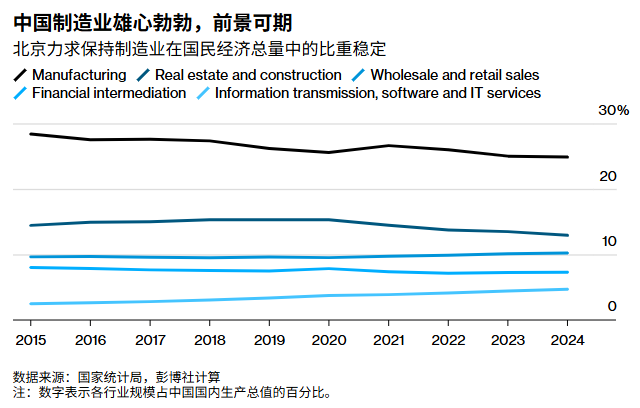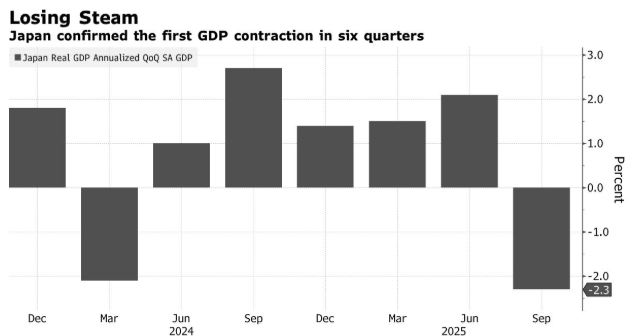As the content of the discussion has not been made public, the sources requested anonymity. One of the sources said that the plan will prioritize technologies including chip manufacturing equipment over the next decade. He also added that the plan may not use the previous name to avoid criticism from Western countries.
One of the people familiar with the matter said that policymakers formulating Beijing’s next five-year plan, which begins in 2026, hope to maintain the proportion of manufacturing in the country’s GDP at a stable level in the medium to long term. This highlights that the goal of rebalancing China’s economy sought by the United States may be difficult to achieve.
According to the person, as part of the review, officials discussed whether the next five-year plan should include a numerical target for the proportion of consumption in China’s GDP. The person said that currently they tend not to do so because the authorities are concerned about the lack of effective tools to stimulate household spending and are reluctant to commit to a specific figure.
The contents of these plans are still under discussion and may undergo significant changes before their release. A person familiar with the matter said that the five-year plan will be announced at the next National People’s Congress in March 2026, while the next manufacturing blueprint could be released at any time before or after the congress.
China’s top economic planning agency, the National Development and Reform Commission (NDRC), did not respond to Bloomberg’s inquiries about the plan.
Discussions currently underway in Beijing suggest that China plans to largely adhere to an overall strategy that has been criticized by the United States and Europe for exacerbating trade imbalances. This has been a characteristic of Sino-US trade negotiations. The US raised tariffs on China to 145% in April, but after the Geneva talks earlier this month, it lowered the average tariff to around 40%.
The Trump administration is attempting to push China to expand consumption while using export controls and tariffs to achieve “strategic decoupling”, striving for self-sufficiency in the United States in sectors such as steel, medicine and semiconductors. Beijing’s resistance to these demands – including maintaining control over rare earth supplies – reflects its own concerns over national security, as well as the US efforts to prevent China from obtaining advanced chips and other technologies.
U.S. Treasury Secretary Scott Bessent told CNBC on May 12: “We can envision that, apart from strategic materials, we can also jointly address the issue.” “We need more manufacturing, and they need more consumption. Therefore, we have the opportunity to jointly achieve rebalancing. We’ll wait and see if it’s feasible.”

Chinese leaders have indicated that it is necessary to stimulate consumption to prevent a deflationary spiral and offset the expected decline in exports due to Trump’s tariff measures. At the National People’s Congress held in March this year, Premier Li Qiang of the State Council stated that “vigorously promoting consumption” is the government’s top priority this year and urged officials to take more measures to “make domestic demand the main engine and stabilizer of economic growth”.
However, since then, officials have taken few new concrete measures to boost consumption as they are waiting to see if their spending plans are sufficient to achieve the growth target of “around 5%” this year. Chinese policymakers still view manufacturing as the core of national security and job creation, and DeepSeek’s breakthrough in the field of artificial intelligence earlier this year has strengthened confidence in the effectiveness of their strategy.

Consumption accounts for about 40% of China’s GDP, while in developed economies, this proportion ranges from 50% to 70%, leading to persistent imbalances and trade tensions. Investment, including manufacturing, also makes up about 40% of China’s economy, which is roughly twice that of the United States and at a historically high level compared to the rest of the world.
The State Council set the goal at that time that China would be built into a world manufacturing power by 2035 and a manufacturing power by 2049, the 100th anniversary of the founding of the People’s Republic of China.


